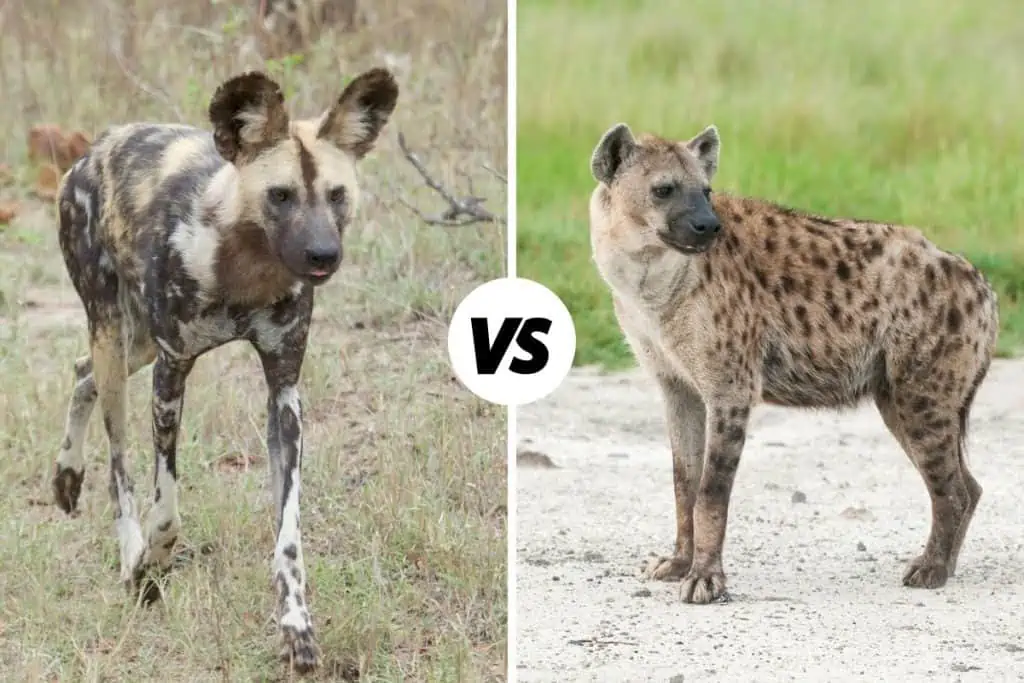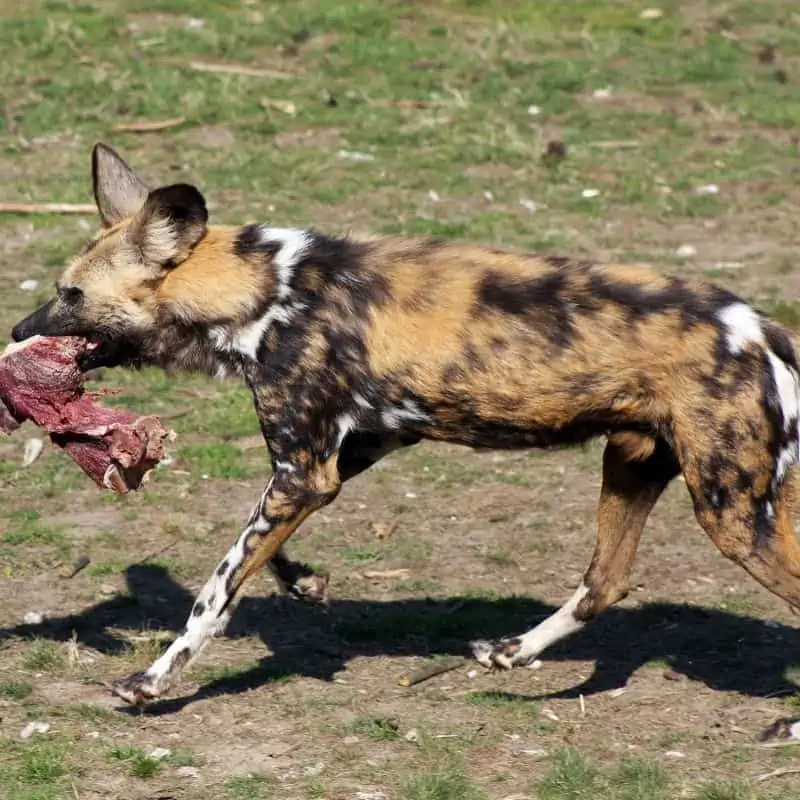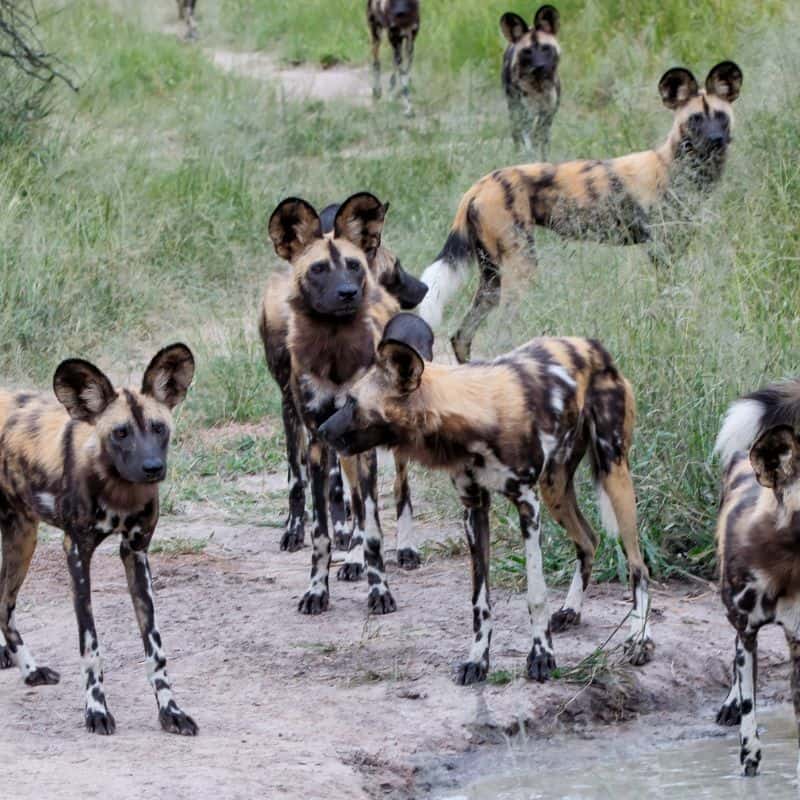Wild dogs and hyenas have long been debated for their similarities and differences. Both are predators found throughout Africa and elsewhere, but what makes them unique from one another? What sets wild dogs apart from hyenas and vice versa?
Wild Dogs and Hyenas are both carnivorous mammals that hunt in packs and share many characteristics, although they differ in physical appearance, habitat, behavior, speed, and diet. Wild Dogs have slender builds and pointed ears for better hearing, while Hyenas have larger heads and thicker fur with smaller, rounded ears.
In this article, we will compare these two animals further and see what sets them apart from one another.

Main Differences Between Hyenas And Wild Dogs
Hyenas and wild dogs are carnivorous mammals known for their distinctive calls and predatory behaviors.
Overview
A hyena is a carnivorous (sometimes omnivorous) mammal and comes in four species: spotted, striped, brown, and aardwolf.
Hyenas have powerful jaws that enable them to crack open bones to get every last drop of nutrients.
Their body shape differs according to their species, but all hyenas have a large head, heavy front legs and shoulders, thick fur, and small ears.
Wild Dogs, or more specifically, African Wild Dogs, are members of the Canis genus, including wolves, jackals, coyotes, and domesticated dogs.
Unlike Hyenas, they have long legs and pointed ears for better hearing. They live in packs of ten individuals (some packs expand to 40 individuals) and hunt for their prey in a coordinated effort.
Habitat
Hyenas are found in Africa, the Middle East, India, and Central Asia.
They live in various habitats, such as savannas, grasslands, and woodlands. They are also found in some mountainous areas.
Wild Dogs are found throughout Africa and parts of Asia. They inhabit various habitats, including grasslands, savannahs, woodlands, mountainous areas, and scrublands.
Diet
Hyenas are opportunistic feeders that eat a wide variety of foods, including small mammals, birds, reptiles, insects, and carrion.
They are also known for their scavenging behavior and will often use the kills of other predators to feed themselves.
Wild Dogs mainly hunt small mammals such as gazelles, hares, and rodents. They also eat birds and occasionally scavenge other animals’ kills.
They are also known to eat fruit and occasionally prey on livestock.

Social Interaction
Hyenas are highly social animals that live in packs. The Spotted hyena is the largest among the four species. They can live in packs of up to 80 individuals.
They communicate with one another using a variety of vocalizations, including howls and screams.
They also use scent marking to establish their territories and boundaries. Hyenas are also known for their scavenging behavior and will often use the kills of other predators to feed themselves.
Wild Dogs are also highly social animals and live in packs of up to 10 individuals. They communicate with one another using a variety of vocalizations and body language.
Wild Dogs hunt cooperatively in packs to bring down larger prey and often share the kills with other members of their pack. They also use scent marking to establish their territories and boundaries.
Speed and Biting Power
Hyenas are well known for their speed, agility, and strength. Hyenas can reach speeds of up to 37 mph when running. They are also very agile and able to navigate rocky terrain with ease.
Hyenas have a powerful bite force of over 1100 psi, which is stronger than a lion and enables them to crush large prey bones. The strength of their jaws also comes in handy when it comes to defending themselves and capturing prey.
Wild dogs are renowned for their speed and agility. Wild Dogs can reach speeds of up to 44 mph when running and are particularly good at chasing down their prey.
They can move quickly and efficiently through dense vegetation, enabling them to pursue their prey with ease. The biting power of a wild dog is comparatively small at only 317 psi (but it’s still almost as powerful as the bite of a Rottweiler).
This biting power is largely attributed to the shape of their skulls and teeth, which are perfectly adapted for gripping and tearing through flesh.
Hunting Behavior
Hyenas are efficient hunters and often ambush their prey or follow it until the animal tires. They also use their powerful jaws to crack the open bones of larger animals to get to the marrow inside.
They also use scavenging techniques when it is more beneficial than actively hunting for food.
In some cases, a single hyena will act as a “bait” to draw out the prey, and all other hyenas will simultaneously attack the animal.
Wild Dogs hunt cooperatively in packs, using strategies such as chasing down their prey and cornering them into a den.
They also employ ambush strategies and will sometimes use the element of surprise to catch their prey off guard. They are also adept at scavenging and often feed on carrion or the kills of other predators.
Threats
Hyenas face threats from habitat loss and fragmentation, illegal hunting, and diseases such as rabies. Hyena-human conflict is a common issue in many parts of Africa and India.
In some areas, hyenas have been shot and killed for preying on livestock or scavenging from crops, even though they primarily feed on wild game and carrion.
They are also heavily persecuted by humans due to their reputation as pests and carriers of disease. Hyenas may be impacted by climate change, too.
Human–wildlife conflict is a major threat, particularly when dogs raid livestock and humans retaliate by killing them. Climate change is also impacting the species, as their habitats are increasingly becoming unstable due to environmental changes.
Additionally, wild dog populations can be directly impacted by competition with other predators, such as lions or hyenas, over food resources and territory.
Wild Dogs also face threats from diseases such as distemper.

Conservation Efforts
Hyenas play an important role in African ecosystems, and their conservation is vital for maintaining biodiversity. Many organizations are working to protect hyena populations in Africa.
One of the main threats to hyena populations is hunting. In some areas, laws have been passed that prohibit the hunting of hyenas and other wildlife species.
Local communities are being educated on the importance of hyenas, and campaigns are underway to raise awareness about the species and its importance in the ecosystem.
Wild Dogs are also protected by national and international laws, and conservation efforts have been implemented in some areas to help protect their populations.
These include habitat protection, anti-poaching initiatives, and education programs. There are also captive breeding programs for Wild Dogs in some countries to help increase their numbers in the wild.
Final Thoughts On Wild Dog And Hyena Differences
Wild Dogs and Hyenas are two iconic African predators, playing very different roles in their ecosystems. Wild Dogs hunt cooperatively, while Hyenas use opportunistic tactics such as scavenging and ambushing their prey.
Both species face serious threats from human-wildlife conflict and climate change, making it essential to ensure they receive the necessary protections and resources for their survival.
Comprehending the differences between Wild Dogs and Hyenas can aid our collective efforts to conserve both species and ensure their continued presence in the wild.
